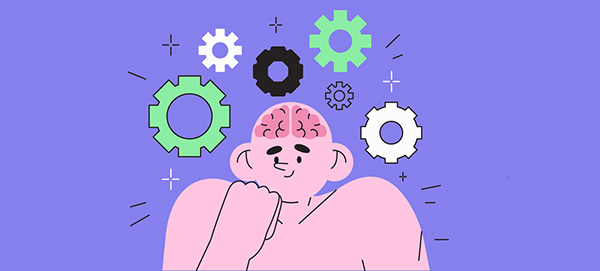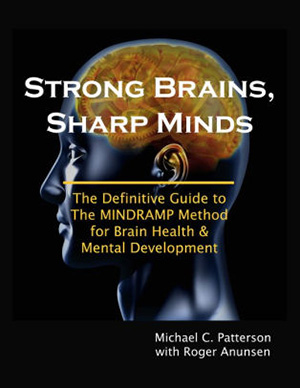Promoting an Age-Friendly Brain

Seven years ago, my colleague Karen Winston and I wrote an AgeWise article about MINDRAMP and their Six CogWheels of Brain Health:
- Physical activity/exercise—Move more; our bodies are built to move.
- Mental stimulation—Stay mentally active. Open your mind to learning and creativity.
- Healthy diet/nutrition—Eat a plant-based diet and avoid processed foods.
- Quality sleep—Quality sleep promotes learning and flushes metabolic waste from the brain.
- Social engagement—As social beings, we thrive when together, falter when divided or isolated.
- Stress management—Learn to embrace useful stress and avoid chronic stress.
The CogWheels were explained to us by Michael C. Patterson and Roger Anunsen, co-founders of MINDRAMP Coaching & Consulting, an organization dedicated to developing brain health programs that work to prevent premature aging and dementia. The CogWheels reflect areas of our life that have been shown to have a profound impact on the health of our brains.
As Michael says, “We intuitively recognize that the health of our bodies and brains is highly influenced by how we move, how we think, what we ingest, how we sleep, how we conduct our social relationships and how we manage our stress.”
As additional research and studies accumulate, our understanding of brain health risk and protective factors becomes deeper and more nuanced. I was excited, therefore, to learn that Michael and Roger have introduced two additional CogWheels to reflect the expanding body of brain health research:
- Medical factors
- Environmental conditions
Why these two new CogWheels?
“We added these two CogWheels,” Michael explained, “to call attention to the importance of staying as healthy as possible and to highlight the incredible impact our environment has on the health and wellbeing of our brains.”
How do medical conditions impact the health of our brains?
“Body and brain work together as an integrated system,” Michael said. “For example, what is good for your heart is good for your brain because your brain needs a steady supply of blood to bring it the oxygen and nutrients it needs to thrive. If blood flow is restricted, the brain is starved of nutrients.
“Another example is the gut-brain connection. Healthy and diverse populations of bacteria in our guts serve to maintain the integrity of our digestive systems. When bacterial species die, toxins in our gut leak into the bloodstream and poison the entire system. And, of course, the medications we take can influence our mental function. Some clearly state on their labels that they cause cognitive decline or mental fuzziness.
“Many of the diseases that plague us in old age and undermine the function of our brains are preventable. If we are serious about protecting ourselves from dementia, we need to provide affordable health care to everyone, and everyone needs to take advantage of the protections that are available.”
How about the environment?
“There are two key points,” Michael said. “The first is that genes are not our destiny. The nature vs. nurture debate has been dispelled. Our state of being—our health and wellbeing—is influenced by our genes as they interact with the environment. Environmental conditions turn genes off and on. Environments affect us down to the fundamental biological level.
“This leads to point two. We are intimately connected to our environmental ecosystems and cannot easily escape their influence. If the air we breathe is polluted, if the water we drink is laden with toxic lead, if our food is laced with pesticides and antibiotics, we will suffer the kind of damage to our cells that leads to dementia.
“To seriously address dementia in America, we need not only to structure our personal environments to promote health, but more important, we need to pressure corporations and governments to stop despoiling the environments we inhabit in their lust for profits and power.”
There is a lot of brain health advice in the popular media. How can we know which ones are sensible and which ones are to be avoided?
“Great question,” Michael responded. “We have identified four criteria that seem to carry the weight of evidence. We use a mnemonic device—The Four C’s—to help remember the four rules of thumb.”
- Causes: “Enduring and effective brain health interventions must address root causes of decline and degeneration. They must stress a preventative rather than a curative approach. Few lasting benefits derive from treating symptoms if the root causes persist. You just get sick all over again. Future generations will continue to suffer from dementia unless we eradicate the conditions that cause premature aging and unnecessary illness, including the vast inequities in access to healthcare, food distribution and economic opportunities.”
- Customized: “Be suspicious of one-size-fits all solutions; they rarely work because they lack flexibility and precision. Each brain is unique because each person’s circumstances and environment are unique. As we age, and have longer to interact with our environments, our brains become increasingly diverse. Effective interventions, therefore, must be customized to address the unique needs of each individual.”
- Continual: “Be wary of quick fixes. To rid ourselves of dementia, we must make lasting lifestyle adjustments and institute enduring systemic changes. You can’t exercise for just one week and expect to reap the health benefits of physical activity. You can’t feed a starving person one hearty meal and expect to stave off the eroding effects of malnutrition.”
- Combinatorial: “Research identifies a growing number of factors that contribute to cognitive decline and dementia. Effective interventions, therefore, must address the array of causes in a combinatorial manner. It’s no good to plug one hole in the dam if ten other leaks are ignored. This is where the eight CogWheels come into play. The eight CogWheel areas cover a broad array of identified risk factors. Each one must be addressed if we want full protection. No single intervention alone will do the trick. Success is found in the synergistic effect of multiple interventions working in combination with each other.”
Good advice. But will we act on the advice? Michael and Roger know that I’ve always been a healthy brain advocate; however, after suffering a traumatic brain injury, I am more committed than ever to supporting brain health initiatives on both individual and societal levels.
 Contributor Mary Pat O’Leary RN., BSN, a senior planner at Aging and Disability Services, Seattle Human Services Department.
Contributor Mary Pat O’Leary RN., BSN, a senior planner at Aging and Disability Services, Seattle Human Services Department.
 Live Long, Live Well
Live Long, Live Well
MINDRAMP co-founders Michael C. Patterson and Roger Anunsen co-authored “Strong Brains, Sharp Minds: The Definitive Guide to the MINDRAMP Method For Brain Health & Mental Development.” Michael hosts the MINDRAMP “Live Long, Live Well” podcasts, which feature provocative discussions with leading thinkers and activists.
![AgeWise King County [logo]](https://www.agewisekingcounty.org/wp-content/themes/agewisekingcounty/images/logo.png)